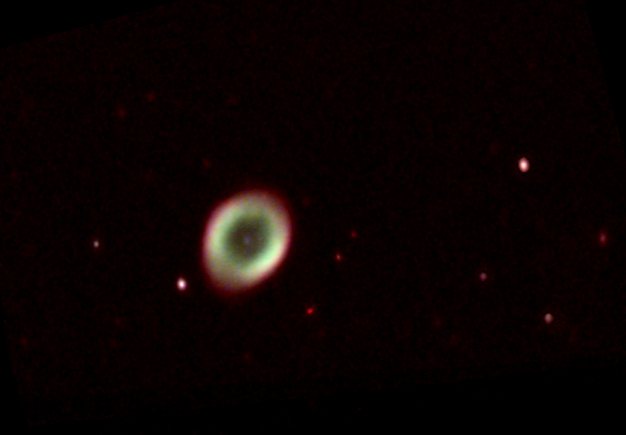
M57: Ring Nebula

RA: 18hr 53min 36sec Dec: 33º 2' 0" Mag: 9.0 Distance: 4100 Light Years Constellation: Lyra
This must be the easiest of all the planetary nebulae to photograph because of its relative brightness. f6.3 is an ideal amount of focal reduction because it keeps the object big enough to be interesting and for the observer to see the outer layers of gas most clearly as well as the central star, which can just be made out in this photo. I took this with the telescope mounted in alt-azimuthal setting and so there are field rotational defects in the outlying stars. But goodness me - what a delight for the beginner in astrophotography!
This photo was taken on the 11th of July 2005, Lyra was at zenith and the sky was absolutely clear. All the individual exposures stacked by Envisage were only 15 seconds long (limited by the alt-az mode and field rotation) and from this, I derived 7 raw images, 3x15seconds, 10x15, 9x15, 5x15, 8x15, 20x15, 14x15, making a total exposure time of 17.25 minutes. The photos were combined with MaximDL and saved as an 8 bit tiff file. Very little by way of processing was required after the the histogram stretch using the Levels command of Photoshop to darken the background and increase the overall brightness of the subject. One small cheat I will admit to is selecting out the faint central star and increasing the blue output using the Curves command in photoshop. I justify this by saying that I was only making visible what we already know is there. Other than this - very little colour manipulation was required as this planetary nebula is so photogenic.
Problems - it would have been nice to demonstrate the surrounding stars in such a rich star-field - a longer exposure might have been able to demonstrate this, only achievable with either a field-derotator or an equatorial mount, the latter of which I only bought this summer.
HOME PICTURES: Deep Sky PICTURES: Solar system PICTURES: Wide field